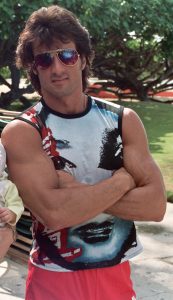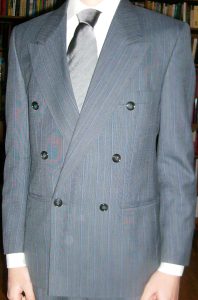Men’s fashion
Early 1980s (1980–1982)
Athletic clothing

In the early 1980s, fashion had moved away from the unkempt hippie look and overdressed disco style of the late 1970s. Athletic clothes were more popular than jeans during this period, as were more subdued colors. Popular colors were black, white, indigo, forest green, burgundy, and different shades of browns, tans, and oranges. Velour, velvet, and polyester were popular fabrics used in clothes, especially button-up and v-neck shirts. Looser pants remained popular during this time, being fairly wide but straight, and tighter shirts were especially popular, sometimes in a cropped athletic style. The general public, at this time, wanted to wear low-maintenance clothing with more basic colors, as the global recession going on at the time kept extravagant clothes out of reach.[10] Also worn were striped tube socks sometimes worn with the top folded over worn with shorts. It was not uncommon to see parents especially fathers wearing these along with their kids.
New wave influence
From the early to mid-1980s, post-punk and new wave music groups influenced mainstream male and female fashion. Commercially made slim-fitting suits, thin neckties in leather or bold patterns, striped T-shirts, Members Only jackets, clubwear, metallic fabric shirts, cat eye glasses, horn rim glasses with brightly colored frames, androgynous neon colored makeup,[76] and pristine leather jackets were widely worn.[77] Common hairstyles included a short quiff, and typical unisex colors for clothing included turquoise, teal, red, neon yellow and white on a blue screen.
Preppy look
- In response to the punk fashion of the mid-late 1970s,[12] there was a throwback to the 1950s Ivy League style. This revival came to be definitively summarized in an enormously popular paperback released in 1980: The Official Preppy Handbook. Popular preppy clothing for men included Oxford shirts, sweaters, turtlenecks, polo shirts with popped collars,[12] khaki slacks, argyle socks, dress pants, Hush Puppies Oxford shoes, Sperrys boat shoes, Eastland boat shoes, brogues, suspenders, seersucker or striped linen suits, corduroy, and cable knit sweaters that were often worn tied around the shoulders.[78]
Mid-1980s (1983–1986)
Miami Vice/Magnum P.I. look and Michael Jackson’s influence
In the mid-1980s, popular trends included wool sport coats, Levi 501s, Hawaiian shirts, shell suits, hand-knit sweaters, sports shirts, hoodies, flannel shirts, reversible flannel vests, jackets with the insides quilted, nylon jackets, gold rings, spandex cycling shorts,[37] cowboy boots,[75] Sperrys boat shoes, Sperrys white sneakers, Eastland boat shoes, khaki pants with jagged seams,[10] and through the end of the decade high waisted ankle length jeans and pants plain or pleated.
Power dressing

Men’s business attire saw a return of pinstripes for the first time since the 1970s. The new pinstripes were much wider than in 1930s and 1940s suits but were similar to the 1970s styles. Three-piece suits began their decline in the early 1980s and lapels on suits became very narrow, akin to that of the early 1960s. While vests (waistcoats) in the 1970s had commonly been worn high with six or five buttons, those made in the early 1980s often had only four buttons and were made to be worn low.[79][80] The thin ties briefly popular in the early ’80s were soon replaced by wider, striped neckties, generally in more conservative colors than the kipper ties of the ’70s. Double breasted suits inspired by the 1940s were reintroduced in the 1980s by designers like Giorgio Armani, Ralph Lauren, and Anne Klein.[79][80] They were known as ‘power suits’, and were typically made in navy blue, charcoal grey or air force blue.
Tropical clothing
As an alternative to the power suit, the safari jacket, Nehru suit and Mao suit remained popular in Australia, South Africa, India, China, and Zaire, where it was known as an Abacost[82] and worn with a leopard print hat resembling the Astrakhan cap. At the same time, young African dandies known as sapeurs rebelled against the post-decolonisation government’s suppression of Western fashions[83] by investing in expensive designer suits from Italy and France and listening to the soukous music of Papa Wemba.[84] This continued until the kleptocratic dictator Mobutu‘s deposition and death in the late 1990s, when the outbreak of a civil war in Zaire resulted in the sapeurs’ disappearance until the 2010s.
Late 1980s (1987–1989)
Doc Martens

Doc Martens were dark shoes or boots with air-cushioned soles that were worn by both sexes in the 1980s. Originally picked up as essential item by early 70’s Skinheads the Cherry Red 8 lacehole boots they were an essential fashion accessory for the suedehead and punk subcultures in the United Kingdom. Sometimes Doc Martens were paired with miniskirts or full, Laura Ashley– style dresses.[89] They were an important feature of the post-punk 1980s Gothic look which featured long, back-combed hair, pale skin, dark eyeshadow, eyeliner, and lipstick, black nail varnish, spiked bracelets and dog-collars, black clothing (often made of gabardine), and leather or velvet trimmed in lace or fishnet material. Corsets were often worn by girls. British bands that inspired the gothic trend include The Cure, Siouxsie and the Banshees, and The Cult. This trend would return in the 1990s.
Parachute pants
Parachute pants are a style of trousers characterized by the use of ripstop nylon or extremely baggy cuts. In the original tight-fitting, extraneously zippered style of the late 1970s and early 1980s, “parachute” referred to the pants’ synthetic nylon material. In the later 1980s, “parachute” may have referred to the extreme bagginess of the pant. These are also referred to as “Hammer” pants, due to rapper MC Hammer‘s signature style. Hammer pants differ from the parachute pants of the 1970s and early 1980s. They are typically worn as menswear and are often brightly colored. Parachute pants became a fad in US culture in the 1980s as part of an increased mainstream popularity of breakdancing.
Unisex accessories
Jewelry
Earrings became a mainstream fashion for male teenagers. Jelly or thin metal bracelets (also known as bangles) were very popular in the 1980s, and would be worn in mass quantities on one’s wrist. Designer jewelry, such as diamonds and pearls, were popular among many women, not only for beauty, but as symbols of wealth and power.
Watches
At the beginning of the decade, digital watches with metal bands were the dominant fashion. They remained popular but lost some of their status in later years. Newer digital watches with built-in calculators and primitive data organizers were strictly for gadget geeks. Adult professionals returned to dial watches by mid-decade. Leather straps returned as an option. By the late 1980s, some watch faces had returned to Roman numerals. In contrast, one ultramodern status symbol was the Movado museum watch. It featured a sleek design with a single large dot at twelve o’clock. The Tank watch by Cartier was a fashion icon that was revived and frequently seen on Cartier advertisements in print. Rolex watches were prominently seen on the television show Miami Vice. Teen culture preferred vibrant plastic Swatch watches. These first appeared in Europe, and reached North America by the mid-1980s. Young people would often wear two or three of these watches on the same arm.
Eyewear
In the first half of the 1980s, glasses with large, plastic frames were in fashion for both men and women. Small metal framed glasses made a return to fashion in 1984 and 1985, and in the late 1980s, glasses with tortoise-shell coloring became popular. These were smaller and rounder than the type that was popular earlier in the decade. Throughout the 1980s, Ray-Ban Wayfarers were extremely popular, as worn by Tom Cruise in the 1983 movie Risky Business.